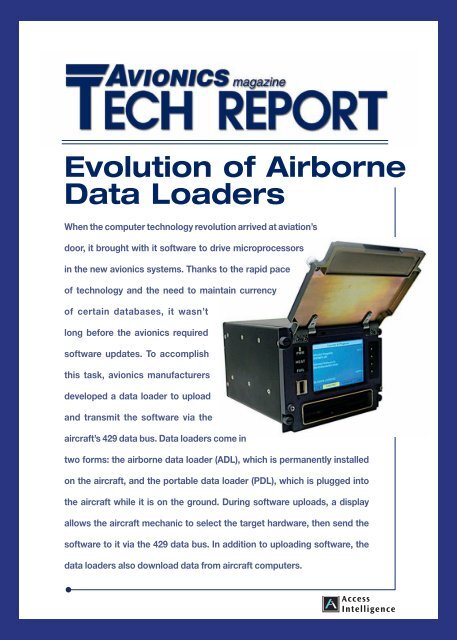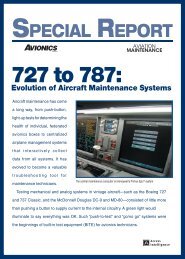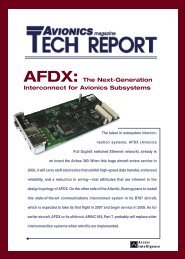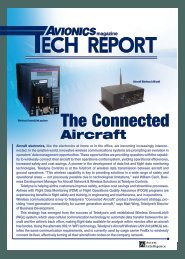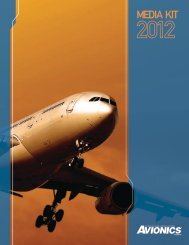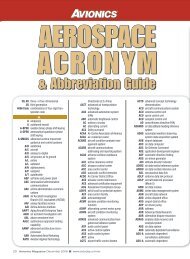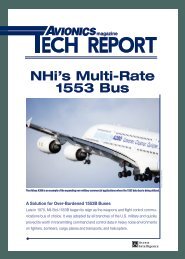Evolution of Airborne Data Loaders - Aviation Today
Evolution of Airborne Data Loaders - Aviation Today
Evolution of Airborne Data Loaders - Aviation Today
Create successful ePaper yourself
Turn your PDF publications into a flip-book with our unique Google optimized e-Paper software.
<strong>Evolution</strong> <strong>of</strong> <strong>Airborne</strong><strong>Data</strong> <strong>Loaders</strong>When the computer technology revolution arrived at aviation’sdoor, it brought with it s<strong>of</strong>tware to drive microprocessorsin the new avionics systems. Thanks to the rapid pace<strong>of</strong> technology and the need to maintain currency<strong>of</strong> certain databases, it wasn’tlong before the avionics requireds<strong>of</strong>tware updates. To accomplishthis task, avionics manufacturersdeveloped a data loader to uploadand transmit the s<strong>of</strong>tware via theaircraft’s 429 data bus. <strong>Data</strong> loaders come intwo forms: the airborne data loader (ADL), which is permanently installedon the aircraft, and the portable data loader (PDL), which is plugged intothe aircraft while it is on the ground. During s<strong>of</strong>tware uploads, a displayallows the aircraft mechanic to select the target hardware, then send thes<strong>of</strong>tware to it via the 429 data bus. In addition to uploading s<strong>of</strong>tware, thedata loaders also download data from aircraft computers.16 AVS 1106 Tech Report.indd 1 10/16/06 12:42:30 PM
While ADLs and PDLs performtheir jobs well, the process<strong>of</strong> updating s<strong>of</strong>tware hasbecome very time-consuming. Thereare many reasons why, beginning withthe original data loader technology.Originally intended simply to transmitdata, data loaders were designedwith a disk drive for a 3.5-inch diskette,which was then the state-<strong>of</strong>-theartstorage media. Because their tasksdid not require it, data loaders hadvery little installed memory.Then s<strong>of</strong>tware began showing upin more avionics units. More updateswere developed. In one case—theflight management system’s navigationdatabase—a s<strong>of</strong>tware update isrequired every 28 days. Some s<strong>of</strong>twareno longer fit within the diskette’s 1.44-Mbyte memory, so multiple diskettesarrived for a single update. The trickle<strong>of</strong> diskettes from s<strong>of</strong>tware providershas become a flood, creating manylogistics problems for airlines.Keeping track <strong>of</strong> all the diskettesis one headache. So too is getting theupdates from the provider to the aircraft.Most s<strong>of</strong>tware providers mail orovernight the diskettes to the airlines,which must distribute the diskettesto all their maintenance stations thathave the aircraft. This adds anotherday or two to the process. Often thereare not enough diskettes to update allthe aircraft simultaneously, so schedulingthem for the updates enters theequation. And loading s<strong>of</strong>tware bydiskette requires a mechanic to monitorthe upload, inserting each diskettewhen prompted by the data loader.The situation was slightly mitigatedabout five years ago, but only for PDLs.They acquired mass memories thatenabled them to store not just one s<strong>of</strong>twareupdate, but the complete set <strong>of</strong>s<strong>of</strong>tware for many aircraft. Some PDLscan even be connected to a company’sintranet and receive s<strong>of</strong>tware from a fewproviders who have begun transmittingupdates via the Internet. Such updatescan be received and be available on thePDL for upload into the aircraft withinan hour or so.This is not the case for ADLs. In aworld where ordinary people automaticallyupdate personal computer s<strong>of</strong>twareelectronically via the Internet and newcomputers don’t even have a 3.5-inchdisk drive, today’s ADLs can only use3.5-inch diskettes to upload s<strong>of</strong>twareupdates. Mechanics must still feed theindividual disks into the ADL, then uploadit to the appropriate hardware. Some ADLmanufacturers even <strong>of</strong>fer two drives tospeed up the onerous upload process.Transmitting s<strong>of</strong>tware via the 429data bus is also extremely slow. Onereason is the 429’s two-wire architecturethat requires every unit to have aseparate 429 connection. One airlinesource estimates it can require up to45 minutes for a mechanic to completejust one upload <strong>of</strong> some s<strong>of</strong>tware. Complicatingthe problem: Upgrading onepiece <strong>of</strong> s<strong>of</strong>tware <strong>of</strong>ten creates the needto update several more; this dominoeffect adds more time to the process.A Better WayAirlines want to migrate to a truly electronicprocess, without using any externalmedia—floppy disk, CD, DVD, whatever.They also want ADLs to have massmemory to store a great deal <strong>of</strong> s<strong>of</strong>tware.Airlines envision receiving the provider’ss<strong>of</strong>tware via a secure Internetconnection, then creating a virtual folderin their company intranet that containsall s<strong>of</strong>tware and updates requiredfor each aircraft type. As updatesarrive, the folder would be updated,and the new s<strong>of</strong>tware and engineeringorders would be immediately transmittedto the maintenance stations.Airlines also want to electronicallyupload the updates to the ADL, ratherthan only to a PDL, via wireless technology,such as IEEE 802.11, which is alreadyused by airline gatelinks (i.e. LANs, orlocal area networks) for other purposes.The data would reside on the ADL untilthe mechanic transfers the s<strong>of</strong>tware tothe components. Rather than use 429for the transfer, airlines want to use theaircraft’s Ethernet. This could reduceupload times to less than 5 minutes.Using an aircraft’s Ethernet to routes<strong>of</strong>tware data from the ADL to targethardware is not a new concept. InNovember 1999, ARINC adopted Report615A, “S<strong>of</strong>tware <strong>Data</strong> Loader UsingEthernet Interface.” It defines data loaders—airborneand portable—that willload avionics s<strong>of</strong>tware over a high-speedinterface using an Ethernet networkTeledyne ControlsTeledyne Controls is a leading provider<strong>of</strong> end-to-end solutions designed toincrease flight safety and operationalefficiency for the aviation communitythrough effective management <strong>of</strong>aircraft data. With more than 40 yearsworking closely with civil and militaryoperators worldwide, the companyhas developed a range <strong>of</strong> productsand services to address the needs <strong>of</strong>their customers and their businessoperation. Teledyne’s wide <strong>of</strong>feringsinclude innovative airborne products,data transfer systems and groundbasedapplications that fit togetherto provide total solutions and delivergreater benefits to the customer.The eADL is an integral part <strong>of</strong> Teledyne’sConnected Aircraft solution,which consists <strong>of</strong> bridging traditionalARINC 429 database-based avionicssystems with new TCP/IP-basedequipment and communication networks.Operational benefits and costsavings can be achieved with Teledyne’sConnected Aircraft solution, inareas as diverse as flight safety andtraining, engineering and maintenance,operations, wireless avionics s<strong>of</strong>twaredistribution for ARINC 615 loading,electronic flight bag (EFB) connectivity,and ACARS over cellular.protocol or other buses using elements<strong>of</strong> the Ethernet protocol, such as AFDX(avionics full-duplex switched Ethernet)and CAN (controller area network) bus.Report 615A also defines mediainterfaces and protocol requirementsfor all data load functions, and itdescribes desired capabilities <strong>of</strong> dataloaders and the standards to ensureinterchangeability <strong>of</strong> equipment andmass storage media. The latest developmentfor 615A is Supplement 3, whichARINC is expected to adopt shortly; itupdates the document with advancessince the previous supplement anddiscusses the use <strong>of</strong> optical and USBdevices for data uploads.The goals <strong>of</strong> 615A are to: load anytarget hardware within 15 minutes; nothave to use hard-wired switches toselect devices to be loaded; use the networknature <strong>of</strong> Ethernet and the addressingfeatures <strong>of</strong> ARINC 615A to supporttarget identification; and limit operator16 AVS 1106 Tech Report.indd 2 10/16/06 12:42:31 PM
16 AVS 1106 Tech Report.indd 4 10/16/06 12:42:46 PM


